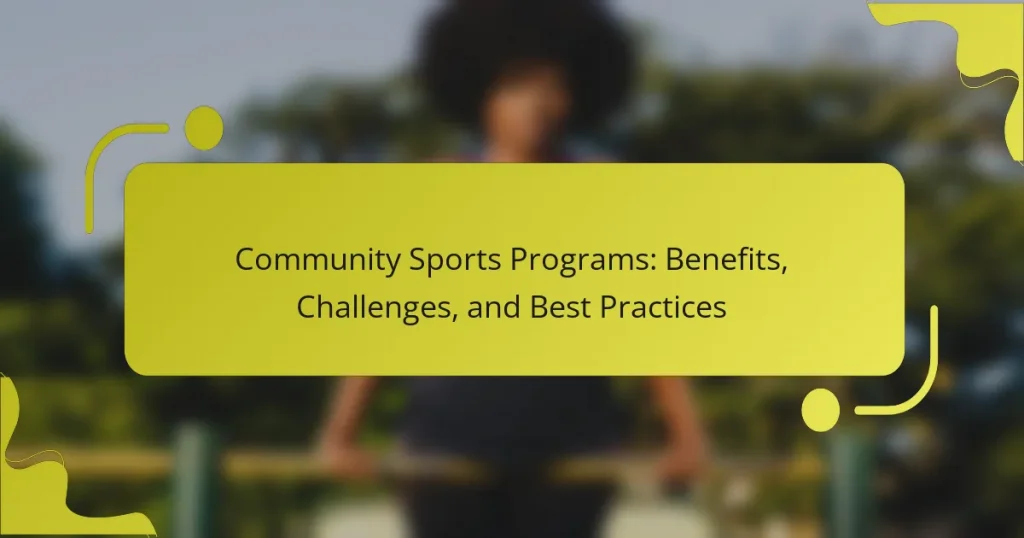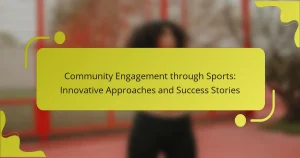Community sports programs enhance physical health, foster social connections, and strengthen community ties. They face challenges such as funding shortages and volunteer recruitment. Implementing best practices can improve inclusivity and engagement. Cultural differences and future trends like technology integration also play significant roles in shaping these programs.

What are the key benefits of community sports programs?
Community sports programs offer numerous benefits, including improved physical health, enhanced social connections, and increased community engagement. These programs promote active lifestyles, reduce obesity rates, and foster teamwork and cooperation among participants.
Additionally, community sports can boost mental well-being by providing a sense of belonging and purpose. They often create inclusive environments that welcome individuals of all skill levels, encouraging lifelong participation in physical activities.
Moreover, such programs can strengthen community ties by bringing together diverse groups, fostering friendships, and building trust among residents. They also provide opportunities for youth development, teaching valuable life skills such as discipline and leadership.
In summary, community sports programs significantly contribute to individual health and community cohesion, making them vital for social development.
How do community sports programs enhance physical health?
Community sports programs significantly enhance physical health by promoting regular exercise and fostering social connections. These programs provide structured activities that encourage participation, leading to improved cardiovascular fitness and reduced obesity rates. Research indicates that individuals involved in community sports experience lower stress levels and enhanced mental well-being. Additionally, these programs can foster a sense of belonging, which contributes to overall health outcomes. Engaging in community sports also reduces the risk of chronic diseases, as participants often adopt healthier lifestyles.
In what ways do community sports programs foster social connections?
Community sports programs foster social connections by creating inclusive environments that encourage teamwork and interaction. Participants build friendships through shared experiences, enhancing community cohesion. Programs often include diverse activities, appealing to various age groups and skill levels, which broadens social networks. As a result, these initiatives reduce isolation and promote a sense of belonging, making communities more resilient and connected.
What role do community sports programs play in youth development?
Community sports programs play a vital role in youth development by promoting physical health, social skills, and teamwork. These programs provide structured environments where young people can engage in regular physical activity, which contributes to improved fitness levels and overall well-being.
Additionally, participation in community sports fosters essential life skills such as leadership, communication, and resilience. Youth learn to work collaboratively towards common goals, enhancing their ability to navigate social situations.
Moreover, community sports programs often address unique needs within local populations, offering opportunities for underrepresented groups. They can serve as a platform for youth to build friendships and support networks, which are crucial for emotional development.
As a result, these programs not only enhance physical capabilities but also contribute significantly to the holistic development of young individuals, preparing them for future challenges in various aspects of life.
How can community sports programs improve mental well-being?
Community sports programs significantly enhance mental well-being by fostering social connections and promoting physical activity. Participation in these programs reduces feelings of isolation and anxiety. Engaging in sports releases endorphins, which improve mood and reduce stress. Additionally, structured activities provide a sense of purpose and achievement. Programs often include diverse age groups, which encourages community bonding and support networks.
What economic benefits do community sports programs provide to local areas?
Community sports programs provide significant economic benefits to local areas by boosting local businesses, creating jobs, and increasing property values. They attract visitors for events and foster community engagement, leading to enhanced social capital. For instance, a study found that community sports events can generate millions in local revenue through tourism and spending. Additionally, these programs promote healthier lifestyles, reducing healthcare costs for communities. Overall, they contribute to economic vitality and social cohesion in local areas.

What challenges do community sports programs face?
Community sports programs face funding shortages, lack of facilities, and volunteer recruitment challenges. These obstacles hinder their ability to provide inclusive and diverse activities. For example, limited financial resources restrict access to equipment and coaching. As a result, programs often struggle to maintain engagement and participation levels. Additionally, competition from other recreational options can divert interest away from community sports initiatives.
How do funding limitations affect community sports programs?
Funding limitations significantly hinder community sports programs by restricting access to resources. These constraints can lead to reduced participation, limited facilities, and fewer coaching opportunities. Programs may struggle to maintain equipment and offer diverse activities, impacting overall community engagement. As a result, the long-term sustainability of these programs is jeopardized, affecting youth development and health outcomes within the community.
What are the common logistical issues in organizing community sports programs?
Common logistical issues in organizing community sports programs include inadequate funding, limited facilities, scheduling conflicts, volunteer shortages, and lack of participant engagement. These challenges can hinder program effectiveness and sustainability. Addressing these issues requires strategic planning and community involvement to ensure successful execution.
How do community sports programs address inclusivity and accessibility?
Community sports programs enhance inclusivity and accessibility by implementing tailored initiatives. These programs often provide adaptive equipment, training for coaches, and inclusive policies that encourage participation from diverse groups.
For example, programs may offer scholarships for underrepresented communities, ensuring financial barriers do not hinder access. They also engage in community outreach to raise awareness and promote participation among individuals with disabilities.
As a result, these initiatives foster a sense of belonging, improve physical health, and build social connections. Ultimately, community sports programs play a crucial role in creating an inclusive environment for all participants.
What impact does volunteer recruitment have on community sports programs?
Volunteer recruitment significantly enhances community sports programs by increasing participation, fostering inclusivity, and building local support. Engaged volunteers improve program quality and sustainability. For example, programs with active volunteer bases report a 30% increase in participant retention. Additionally, volunteers often bring unique skills, enriching the overall experience. A strong recruitment strategy can lead to diverse volunteer demographics, which positively impacts community engagement and outreach efforts.

Which best practices can enhance the effectiveness of community sports programs?
Implementing best practices can significantly enhance community sports programs. Key strategies include fostering inclusive participation, ensuring consistent funding, and providing trained volunteers. Engaging local schools and businesses can strengthen community ties, while regular feedback from participants helps tailor programs effectively. Establishing clear goals and measuring outcomes also boosts program success.
How can community engagement improve sports program participation?
Community engagement significantly boosts sports program participation by fostering a sense of belonging and ownership. When community members actively participate in planning and promoting sports initiatives, they create an inclusive environment that attracts diverse participants. Engaged communities often provide resources, volunteers, and local support, enhancing program visibility and accessibility.
For example, research shows that programs with strong community ties see up to a 40% increase in participation rates. This engagement also cultivates lasting relationships among participants, encouraging continued involvement and a vibrant sports culture.
What strategies can be implemented for effective program marketing?
Effective program marketing for community sports programs involves targeted outreach, engaging content, and community partnerships. Utilize social media platforms to share success stories and program highlights. Collaborate with local organizations to expand reach and credibility. Offer incentives for referrals to encourage participation. Implement feedback mechanisms to continuously improve offerings and address community needs.
How do partnerships with local organizations benefit community sports programs?
Partnerships with local organizations significantly enhance community sports programs by providing resources, expertise, and outreach. These collaborations often lead to increased funding, better facilities, and access to trained volunteers. Additionally, they foster a sense of community ownership, encouraging greater participation and support. Engaging local organizations can also improve program visibility, attracting diverse participants and promoting inclusivity.
What are the key components of a successful community sports program evaluation?
A successful community sports program evaluation includes clear objectives, participant feedback, measurable outcomes, and stakeholder involvement. These components ensure the program meets community needs and fosters engagement.
1. Clear Objectives: Define specific goals to guide the evaluation process.
2. Participant Feedback: Collect insights from participants to assess satisfaction and areas for improvement.
3. Measurable Outcomes: Use metrics to evaluate program effectiveness and impact on the community.
4. Stakeholder Involvement: Engage community members and organizations for diverse perspectives and support.
What common mistakes should be avoided in managing community sports programs?
Common mistakes in managing community sports programs include inadequate planning, lack of community engagement, insufficient funding, and neglecting volunteer support. These errors can hinder program effectiveness and sustainability.
1. Inadequate planning can lead to poorly structured activities, resulting in low participation rates.
2. Lack of community engagement may cause programs to miss the needs and interests of local participants.
3. Insufficient funding limits resources for equipment, facilities, and promotion, impacting program quality.
4. Neglecting volunteer support can lead to burnout and high turnover, affecting program continuity.
5. Failing to evaluate program outcomes prevents necessary adjustments, reducing overall impact.

How do cultural differences influence community sports program structures?
Cultural differences significantly shape community sports program structures by influencing participation, organization, and values. Programs may adapt to local traditions, social norms, and community needs, impacting engagement levels. For example, in cultures that prioritize teamwork, programs may emphasize cooperative activities. Conversely, in cultures valuing individual achievement, competitive formats may prevail. These adaptations ensure programs resonate with community members, enhancing overall effectiveness and participation rates.
What unique attributes define community sports programs in diverse regions?
Unique attributes that define community sports programs in diverse regions include cultural relevance, accessibility, varying funding sources, and local leadership involvement. These factors shape the programs’ effectiveness and engagement levels. Cultural relevance ensures that activities resonate with community values. Accessibility addresses the needs of various demographics, promoting inclusivity. Funding sources can vary widely, impacting program sustainability. Local leadership involvement fosters a sense of ownership and accountability, enhancing program success.
How do community sports programs adapt to local customs and traditions?
Community sports programs adapt to local customs and traditions by incorporating culturally relevant activities and values. They engage community members in the planning process to ensure alignment with local preferences. Programs may feature traditional games, celebrate local festivals, and promote inclusivity. This adaptation enhances participation and fosters a sense of belonging. For example, a program may integrate regional sports, which can increase community pride and cohesion.
What are some rare but impactful initiatives in community sports programs?
Innovative community sports programs can significantly enhance local engagement and health. Rare but impactful initiatives include mobile sports units, which bring equipment and coaching to underserved areas, and mentorship programs pairing youth with local athletes. Another initiative is community-led sports festivals that celebrate diversity and promote inclusion through various sports. These programs often lead to increased participation and stronger community bonds.

What future trends are shaping community sports programs?
Future trends shaping community sports programs include increased focus on inclusivity, technology integration, and health awareness. Programs are evolving to accommodate diverse populations, utilizing digital platforms for engagement and tracking health metrics. As a result, community sports are becoming more accessible and data-driven, enhancing participation and overall well-being.
How is technology influencing community sports program delivery?
Technology significantly enhances community sports program delivery by improving accessibility, engagement, and efficiency. Digital platforms facilitate communication, allowing organizations to reach a broader audience and streamline registration processes.
Mobile applications enable real-time updates and notifications, fostering community involvement. Wearable technology provides athletes with performance tracking, enhancing training and health management.
Data analytics helps organizations assess program effectiveness and participant satisfaction, guiding future improvements. Social media platforms create a sense of community, encouraging participation and collaboration among members.
As a result, technology transforms community sports programs, making them more inclusive and effective in meeting the needs of diverse populations.
What role does sustainability play in the future of community sports programs?
Sustainability is crucial for the future of community sports programs as it ensures long-term viability and environmental responsibility. Implementing sustainable practices can enhance community engagement, reduce operational costs, and promote healthier lifestyles. For example, using renewable energy sources and eco-friendly materials can minimize the carbon footprint of sports facilities. As a result, communities can foster a culture of sustainability while providing accessible sports opportunities. This dual focus on environmental stewardship and community well-being strengthens the overall impact of sports programs.
How can community sports programs evolve to meet changing demographics?
Community sports programs must adapt to changing demographics by focusing on inclusivity, accessibility, and diverse programming. Engaging underrepresented groups enhances participation and community cohesion. For example, offering programs tailored for various age groups, abilities, and cultural backgrounds can attract a broader audience. Additionally, leveraging technology for outreach and feedback can help programs remain relevant and responsive to community needs. This evolution ensures that community sports programs foster a sense of belonging and promote physical activity across diverse populations.
What innovative funding models are emerging for community sports programs?
Innovative funding models for community sports programs include crowdfunding, public-private partnerships, and social impact bonds. These approaches leverage diverse resources to enhance financial sustainability. Crowdfunding allows community members to directly support local initiatives, while public-private partnerships can provide shared investment and expertise. Social impact bonds focus on measurable outcomes, attracting private investors to fund programs that demonstrate success. These models address funding challenges and create opportunities for growth and engagement in community sports.
What expert tips can help optimize community sports program outcomes?
To optimize community sports program outcomes, focus on clear communication, inclusive practices, and consistent evaluation. Engaging community members fosters ownership and participation. Develop partnerships with local organizations to enhance resources and outreach. Regularly assess program impact to identify areas for improvement and celebrate successes.




